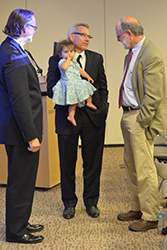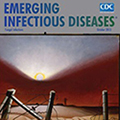 Newspapers in Tucson and Phoenix included articles Oct. 18 on a two-state collaboration of health care specialists for an NIH randomized clinical trial for treating Valley Fever and efforts to develop a vaccine that are led by researchers at the University of Arizona College of Medicine – Tucson.
Newspapers in Tucson and Phoenix included articles Oct. 18 on a two-state collaboration of health care specialists for an NIH randomized clinical trial for treating Valley Fever and efforts to develop a vaccine that are led by researchers at the University of Arizona College of Medicine – Tucson.
You can read the articles here:
- “Partnership with California fostering valley fever awareness” | Arizona Daily Star
- “Doctors: More research needed to rid Arizona, California of rampant Valley Fever” | Arizona Republic
For more topics on UA Health Sciences in the news, click here.
 Dr. Galgiani, on right at left, with Rep. Schweikert (center) and Shay Stautz, the Wasington, DC, lobbyst for the University of Arizona. They're joined in the photo above by GOP majority leader, Rep. McCarthy.
Dr. Galgiani, on right at left, with Rep. Schweikert (center) and Shay Stautz, the Wasington, DC, lobbyst for the University of Arizona. They're joined in the photo above by GOP majority leader, Rep. McCarthy.
Tuesday’s articles focus on a press conference convened Oct. 17 at Banner – University Medical Center Phoenix by U.S. Congressional Valley Fever Task Force Co-Chairpersons and U.S. Representatives David Schweikert (R.-Phoenix) and Kevin McCarthy (R.-Bakersfield, Calif.)—the House majority leader—to announce research developments in conjunction with the UA Valley Fever Center for Excellence.
They spotlight a $9.7 million National Institutes of Health (NIH) grant to Duke University, for which the UA has a $1.9 million subcontract for the state of Arizona (see DOM news archive article), to test use of fluconazole as an early treatment on Valley Fever victims and collaborative efforts by center founding director John N. Galgiani, MD, a UA professor of infectious diseases, to develop a vaccine for pets and humans. Dr. Galgiani and Ken Knox, MD, chief of the UA Division of Pulmonary, Allergy, Critical Care and Sleep Medicine, are co-principal investigators on the Arizona portion of the grant.
Created in 1996 by the Arizona Board of Regents, the Valley Fever Center for Excellence is leading the way in developing viable treatments to more quickly recognize and possibly cure Valley Fever. That includes development of vaccines, including nikkomycin Z (NikZ), now outsourced to Tucson-based Valley Fever Solutions Inc., for which Dr. Galgiani serves as chief medical officer. He said the UA also is working with an Irvine, Calif., company, Anivive Lifesciences to develop a vaccine. Grant proposals, he added, have been submitted to the National Institutes of Health for $6 million and the Arizona Biomedical Research Commission for $250,000 to further that work.
“With the majority leader of the GOP coming to Arizona, we’re bringing national attention to this disease and you can credit that to the University of Arizona because of the Valley Fever Center for Excellence and the Division of Infectious Diseases,” Dr. Galgiani said.
Founded in July 2013, the Congressional Valley Fever Task Force consists of a bipartisan group of 11 members of Congress—nine Republicans and two Democrats from California (9), Arizona (1) and Texas (1)—committed to improving awareness, reducing the risk of misdiagnoses, and finding a viable cure. The task force also seeks to raise awareness and initiate dialogue within the medical community about Valley Fever.
Valley Fever, or coccidioidomycosis, is primarily a disease of the lungs commonly confused with pneumonia that’s caused by fungal spores in the soil found largely in the U.S. Southwest and northwestern Mexico. Two-thirds of all reported U.S. cases occur in Arizona and nearly all of those are from a 150-mile stretch of urban areas from Pima, through Pinal and into Maricopa Counties. Kern County, Calif., which includes Bakersfield, rounds out the top four U.S. counties with Valley Fever cases.
Valley Fever is often the second most reported infectious disease for the Arizona Department of Health Services. The U.S. Centers for Disease Control and Prevention tallied 8,232 cases nationwide in 2014. AzDHS reported 7,622 in Arizona alone in 2015. Still, both say those numbers are likely low due to confusion between the disease and common pneumonia.
In other recent developments,
- The Valley Fever Center for Excellence announced its 11th annual $300,000 grant was received earlier this month from the J.T. Tai & Co. Foundation of New York. That’s $3.3 million the foundation has given to date. It was established in 1983 by the late Jun Tsei Tai, the owner of a real estate management company and an internationally renowned dealer in Asian art. It primarily supports medical education and health care. Expressing his gratitude, Dr.Galgiani noted foundation president F. Richard Hsu has a home in Glendale, Ariz., where he became aware of Valley Fever. “He’s very invested in watching this thing move forward,” Dr. Galgiani said. “He realizes the importance of this disease to the Southwest and sees how this funding is really making a huge difference in awareness and research into treatment and a possible cure.”
 Look for a UANews article soon on Marc J. Orbach, PhD, a professor of plant sciences in the UA College of Agriculture and Life Sciences, and a research breakthrough on the mission to develop an effective vaccine for Valley Fever. The article highlights findings in a scientific paper Dr. Orbach co-authored, "A Coccidioides CPS1 deletion mutant is avirulent and protects mice from lethal infection," that was published this August by the journal Infection and Immunity. Other authors include Lisa F. Shubitz, DVM; M. Alejandra Mandel, PhD; Hien T. Trinh; Adam S. Buntzman, PhD; Jeffrey A. Frelinger, PhD, and Dr. Galgiani—all from the UA. Pictured right is Dr. Orbach from a March 2015 Arizona Daily Star article on his work to develop a vaccine. [Photo used by permission]
Look for a UANews article soon on Marc J. Orbach, PhD, a professor of plant sciences in the UA College of Agriculture and Life Sciences, and a research breakthrough on the mission to develop an effective vaccine for Valley Fever. The article highlights findings in a scientific paper Dr. Orbach co-authored, "A Coccidioides CPS1 deletion mutant is avirulent and protects mice from lethal infection," that was published this August by the journal Infection and Immunity. Other authors include Lisa F. Shubitz, DVM; M. Alejandra Mandel, PhD; Hien T. Trinh; Adam S. Buntzman, PhD; Jeffrey A. Frelinger, PhD, and Dr. Galgiani—all from the UA. Pictured right is Dr. Orbach from a March 2015 Arizona Daily Star article on his work to develop a vaccine. [Photo used by permission] Janis E. Blair, MD, an infectious diseases specialist from the Mayo Clinic in Scottsdale, Ariz., will be the keynote speaker at the 21st Annual Farness Lecture on Wed., Nov. 16, in UAHS Room 5403, noon-1 p.m. The lecture is part of the offering from the UA Department of Medicine Grand Rounds and will also be webcast live and archived for future viewing. Dr. Blair was part of the 16-member panel that oversaw updating the “2016 Infectious Diseases Society of America (IDSA) Clinical Practice Guideline for the Treatment of Coccidioidomycosis” released in late July. Her topic: “Coccidioidomycosis in Transplantation.” Click here to learn more about the event.
Janis E. Blair, MD, an infectious diseases specialist from the Mayo Clinic in Scottsdale, Ariz., will be the keynote speaker at the 21st Annual Farness Lecture on Wed., Nov. 16, in UAHS Room 5403, noon-1 p.m. The lecture is part of the offering from the UA Department of Medicine Grand Rounds and will also be webcast live and archived for future viewing. Dr. Blair was part of the 16-member panel that oversaw updating the “2016 Infectious Diseases Society of America (IDSA) Clinical Practice Guideline for the Treatment of Coccidioidomycosis” released in late July. Her topic: “Coccidioidomycosis in Transplantation.” Click here to learn more about the event.- Just in time for Halloween, Dr. Galgiani is featured in the Oct. 27 Animal Planet’s “Monsters Inside Me”
 TV broadcast regarding a Tucson woman told she had lung cancer who got a thoracotomy and then found out it was Valley Fever. As the foremost expert on the respiratory disease, he was asked for an interview, filmmakers came to see him June 26 in Phoenix and the rest you’ll see next week. Don’t get too excited, he stressed, as “it’s not a news story.” He likens it more to an overdone dramatization, which if you’ve seen the program hits the mark. [NOTE: He also appeared in the “My Christmas from Hell” episode that aired Dec. 18, 2013.]
TV broadcast regarding a Tucson woman told she had lung cancer who got a thoracotomy and then found out it was Valley Fever. As the foremost expert on the respiratory disease, he was asked for an interview, filmmakers came to see him June 26 in Phoenix and the rest you’ll see next week. Don’t get too excited, he stressed, as “it’s not a news story.” He likens it more to an overdone dramatization, which if you’ve seen the program hits the mark. [NOTE: He also appeared in the “My Christmas from Hell” episode that aired Dec. 18, 2013.] - Dr. Galgiani co-authored an article that appears in the October 2016 issue of Emerging Infectious Diseases (EID Journal)—“Effect of Geography on the Analysis of Coccidioidomycosis-Associated Deaths, United States”
 —that better tracks racial disparities in mortality reported to the CDC involving Valley Fever infections from 1990-2008. Updating a 2012 report by UCLA, they narrowed their study to Arizona and California, where the vast majority of infections occur, and used state rather than national demographics. As a result, African Americans, ranked low with a national racial denominator, suddenly had a much higher death rate for complicated infections; and Native Americans, who saw a six-fold mortality increase in the UCLA study, showed a much higher survival rate, although it varied with diabetes as a co-morbidity. “It’s all because you had the wrong denominator,” Dr. Galgiani said. “This report is consistent with everything we know about bad outcomes with Valley Fever.”
—that better tracks racial disparities in mortality reported to the CDC involving Valley Fever infections from 1990-2008. Updating a 2012 report by UCLA, they narrowed their study to Arizona and California, where the vast majority of infections occur, and used state rather than national demographics. As a result, African Americans, ranked low with a national racial denominator, suddenly had a much higher death rate for complicated infections; and Native Americans, who saw a six-fold mortality increase in the UCLA study, showed a much higher survival rate, although it varied with diabetes as a co-morbidity. “It’s all because you had the wrong denominator,” Dr. Galgiani said. “This report is consistent with everything we know about bad outcomes with Valley Fever.”  Cronkite News from ASU’s Arizona PBS recently did a story that got picked up by a number of newspapers and TV stations on Dr. Galgiani’s participation as lead author of “New, simpler guidelines created to treat Valley Fever” released this summer by the IDSA. Two other physicians from the UA College of Medicine – Tucson were among the 16-member panel that oversaw the guidelines’ update.
Cronkite News from ASU’s Arizona PBS recently did a story that got picked up by a number of newspapers and TV stations on Dr. Galgiani’s participation as lead author of “New, simpler guidelines created to treat Valley Fever” released this summer by the IDSA. Two other physicians from the UA College of Medicine – Tucson were among the 16-member panel that oversaw the guidelines’ update.
ALSO SEE:
"UA Researchers Closer Than Ever to Valley Fever Vaccine" | Posted Oct. 27, 2016
"Dr. Hart Boosts Health Sciences' Innovation in Letter, Blog Post and Report" | Posted: Dec. 18, 2015

